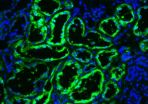(Press-News.org) Education and behavior have a greater impact on the development of nearsightedness than do genetic factors: With each school year completed, a person becomes more nearsighted. The higher the level of education completed, the more severe is the impairment of vision. These are the conclusions drawn by researchers at the Department of Ophthalmology at the Mainz University Medical Center from the results of the first population-based cohort study of this condition. A nearsighted eye is one in which the eyeball is too long in relation to the refractive power of the cornea and lens. As a result, distant objects are displayed on the retina out of focus. The eyeball continues to grow in humans until they reach adulthood and this means that myopia can also continue to progress in persons who have reached their 30s. It has been shown that both genetic predisposition as well as environmental stimuli play a role in the development of nearsightedness.
The team at the Department of Ophthalmology at the Mainz University Medical Center led by Professor Norbert Pfeiffer and PD Dr. Alireza Mirshahi found strong evidence that attaining a higher level of education and spending more years in school are two factors associated with a greater prevalence and severity of nearsightedness, or myopia. The results of the ophthalmologic segment of the population-based Gutenberg Health Study (GHS) undertaken by the Mainz University Medical Center provides evidence that environmental factors may outweigh genetic factors in the development of myopia. A related article by the Mainz team has just been published in the American Academy of Ophthalmology's scientific journal, Ophthalmology.
Nearsightedness is widespread. However, it has become more prevalent around the world in recent years and presents a growing global health and economic concern. Severe myopia is a major cause of visual impairment and is closely associated with an increased risk of complications, such as retinal detachment, macular degeneration, premature cataracts, and glaucoma. Developed Asian countries report increasing myopia rates of up to 80 percent. The rapidity of this escalation suggested that environmental factors, for example near work such as reading, using a computer, and higher education, might play an important role.
To analyze the correlation between myopia development and education, researchers at the Mainz University Medical Center examined nearsightedness in 4,658 Germans aged 35 to 74, excluding anyone with cataracts or who had undergone refractive surgery. This research was undertaken as part of the Gutenberg Health Study and the results demonstrate that myopia becomes more prevalent with a higher level of education. Only 24 percent of the nearsighted subjects had no high school education or other training, while 35 percent of high school graduates and vocational school graduates were nearsighted. In contrast, no less than 53 percent of university graduates were nearsighted.
In addition to education levels completed, the Mainz-based researchers also found that people who spent more years in school proved to be more myopic, with nearsightedness worsening for each year of school. Furthermore, the researchers looked at the effects of 45 genetic markers, but found that these have a much lower impact on the severity of nearsightedness compared to the level of education achieved.
So what can be done to remedy this situation? It is not possible to 'cure' nearsightedness; it can only be corrected with visual aids or by surgical intervention designed to change refractive parameters. Attempts to slow the progression of myopia with drugs, special spectacles, or contact lenses have proven unsuccessful to date. Recent studies among children and young adults in Denmark and Asia showed that the risk for the development of myopia may be less with spending more time outdoors and, thus, by greater exposure to sunlight. Fifteen hours per week are advisable, while, at the same time, the eyes should not be used for close-up activities such as reading, watching TV, or using computers and smart phones for more than 30 hours per week. "Since students appear to be at a higher risk for nearsightedness, it makes sense to encourage them to spend more time outdoors as a precaution," said PD Dr. Alireza Mirshahi, lead author of the study.
The Gutenberg Health Study (GHS) is an interdisciplinary, population-based, prospective, monocenter cohort study, which has been conducted at the Mainz University Medical Center since 2007. Cardiovascular diseases, cancer, eye diseases, metabolic disorders as well as immune system and mental disorders are being investigated as part of the study. The goal of the study is to improve the individual risk prediction for these diseases. To this end, lifestyle, psychosocial factors, environment, clinical laboratory parameters, and the severity of any subclinical disorder are being taken into consideration. A comprehensive biorepository is being developed so that molecular biological investigations can be conducted. During the baseline visit, 15,010 participants aged 35 to 74 years were invited to participate in a 5-hour examination program at the study center. This was followed by a computer-assisted telephone interview (CATI) using a standardized questionnaire and the assessment of diseases and health problems after 2.5 years. All endpoints will be subjected to extensive validation. In April 2012, a detailed follow-up examination of participants similar to the baseline examination was conducted at the center five years after their inclusion in the study. The aim is to continue to monitor the cohort and conduct further tests.
INFORMATION:
Further information: Mirshahi A. et al., Myopia and Level of Education: Results from the Gutenberg Health Study; Manuscript no. 2013-797. article in press
Contact
Professor Dr. Norbert Pfeiffer and PD Dr. Alireza Mirshahi
Department of Ophthalmology
Mainz University Medical Center
Johannes Gutenberg University Mainz
D 55131 Mainz, GERMANY
phone +49 6131 17-7085
fax +49 6131 17-6620
e-mail: alireza.mirshahi@unimedizin-mainz.de
Press contact
Barbara Reinke
Press and Public Relations
Mainz University Medical Center
Johannes Gutenberg University Mainz
D 55131 Mainz, GERMANY
phone +49 6131 17-7428
fax +49 6131 17-3496
e-mail: pr@unimedizin-mainz.de
About the University Medical Center of Johannes Gutenberg University Mainz
The University Medical Center of Johannes Gutenberg University Mainz is the only facility of its kind in Rhineland-Palatinate. It consists of more than 60 clinics, institutes, and departments. Research and teaching are inextricably linked with medical treatment. Approximately 3,500 students of medicine and dentistry are trained in Mainz on a continuous basis. More information can be found at http://www.unimedizin-mainz.de/index.php?L=1.
Nearsightedness increases with level of education and longer schooling
Scientific study undertaken by the Mainz University Medical Center shows correlation between education and nearsightedness
2014-07-21
ELSE PRESS RELEASES FROM THIS DATE:
Heart disease: First Canadian survey shows women unaware of symptoms and risk factors
2014-07-21
OTTAWA, July 21, 2014 – A new survey, ordered by the University of Ottawa Heart Institute, shows that a majority of Canadian women lack knowledge of heart disease symptoms and risk factors, and that a significant proportion is even unaware of their own risk status. The findings underscore the opportunity for patient education and intervention regarding risk and prevention of heart disease.
Heart disease is a leading cause of morbidity and mortality in men and women. Our understanding of heart disease stems chiefly from clinical trials on men, but key features of the disease ...
Circumcision does not promote risky behavior by African men
2014-07-21
Men do not engage in riskier behaviors after they are circumcised, according to a study in Kenya by University of Illinois at Chicago researchers.
Three clinical trials have shown that male circumcision significantly reduces the risk of acquiring HIV in young African men. However, some experts have suggested that circumcision, if promoted as an HIV preventive, may increase promiscuity or decrease condom use. This 'risk compensation' could diminish the effectiveness of medical male circumcision programs.
The new study, published online July 21 in the journal AIDS and ...
Brain waves show learning to read does not end in 4th grade, contrary to popular theory
2014-07-21
Teachers-in-training have long been taught that fourth grade is when students stop learning to read and start reading to learn. But a new Dartmouth study in the journal Developmental Science tested the theory by analyzing brain waves and found that fourth-graders do not experience a change in automatic word processing, a crucial component of the reading shift theory. Instead, some types of word processing become automatic before fourth grade, while others don't switch until after fifth.
The findings mean that teachers at all levels of elementary school must think of themselves ...
Large twin study suggests that language delay due more to nature than nurture
2014-07-21
A study of 473 sets of twins followed since birth found that compared to single-born children, 47 percent of 24-month-old identical twins had language delay compared to 31 percent of non-identical twins. Overall, twins had twice the rate of late language emergence of single-born children. None of the children had disabilities affecting language acquisition.
The results of the study were published in the June 2014 Journal of Speech, Language, and Hearing Research.
University of Kansas Distinguished Professor Mabel Rice, lead author, said that all of the language traits ...
Study examines incentives to increase medical male circumcision to help reduce risk of HIV
2014-07-21
Among uncircumcised men in Kenya, compensation in the form of food vouchers worth approximately U.S. $9 or $15, compared with lesser or no compensation, resulted in a modest increase in the prevalence of circumcision after 2 months, according to a study published by JAMA. The study is being released to coincide with its presentation at the International AIDS Conference.
Following randomized trials that demonstrated that medical male circumcision reduces men's risk of HIV acquisition by 50 percent to 60 percent, UNAIDS and the World Health Organization recommended the ...
Fecal transplants let packrats eat poison
2014-07-21
Salt Lake City – Woodrats lost their ability to eat toxic creosote bushes after antibiotics killed their gut microbes. Woodrats that never ate the plants were able to do so after receiving fecal transplants with microbes from creosote-eaters, University of Utah biologists found.
The new study confirms what biologists long have suspected: bacteria in the gut – and not just liver enzymes – are "crucial in allowing herbivores to feed on toxic plants," says biologist Kevin Kohl, a postdoctoral researcher and first author of the paper published online today in the journal ...
Why are more people in the UK complaining about their doctors?
2014-07-21
The report – "Understanding the Rise in Fitness to Practise Complaints from Members of the General Public" – is published today.
An increase in complaints has been seen across the UK, which suggests wider social trends rather than localised issues. A large number of complaints did not progress because the issues raised could not be identified, which suggests that the GMC is receiving complaints outside its remit. According to the report, this points towards problems with the wider complaint-handling system and culture.
While the report does not point to any specific ...
UEA research shows oceans vital for possibility for alien life
2014-07-21
Researchers at the University of East Anglia have made an important step in the race to discover whether other planets could develop and sustain life.
New research published today in the journal Astrobiology shows the vital role of oceans in moderating climate on Earth-like planets.
Until now, computer simulations of habitable climates on Earth-like planets have focused on their atmospheres. But the presence of oceans is vital for optimal climate stability and habitability.
The research team from UEA's schools of Maths and Environmental Sciences created a computer ...
New findings show strikingly early seeding of HIV viral reservoir
2014-07-20
BOSTON – The most critical barrier for curing HIV-1 infection is the presence of the viral reservoir, the cells in which the HIV virus can lie dormant for many years and avoid elimination by antiretroviral drugs. Very little has been known about when and where the viral reservoir is established during acute HIV-1 infection, or the extent to which it is susceptible to early antiretroviral therapy (ART).
Now a research team led by investigators at Beth Israel Deaconess Medical Center (BIDMC) in collaboration with the U.S. Military HIV Research Program has demonstrated that ...
Metabolic enzyme stops progression of most common type of kidney cancer
2014-07-20
PHILADELPHIA -- In an analysis of small molecules called metabolites used by the body to make fuel in normal and cancerous cells in human kidney tissue, a research team from the Perelman School of Medicine at the University of Pennsylvania identified an enzyme key to applying the brakes on tumor growth. The team found that an enzyme called FBP1 – essential for regulating metabolism – binds to a transcription factor in the nucleus of certain kidney cells and restrains energy production in the cell body. What's more, they determined that this enzyme is missing from all kidney ...
LAST 30 PRESS RELEASES:
IADR elects George Belibasakis as vice-president
Expanding the search for quantum-ready 2D materials
White paper on leadership opportunities for AI to increase employee value released by University of Phoenix College of Doctoral Studies
ASH 2025: New combination approach aims to make CAR T more durable in lymphoma
‘Ready-made’ T-cell gene therapy tackles ‘incurable’ T-cell leukemia
How brain activity changes throughout the day
Australian scientists reveal new genetic risk for severe macular degeneration
GLP-1 receptor agonists likely have little or no effect on obesity-related cancer risk
Precision immunotherapy to improve sepsis outcomes
Insilico Medicine unveils winter edition of Pharma.AI, accelerating the path to pharmaceutical superintelligence
Study finds most people trust doctors more than AI but see its potential for cancer diagnosis
School reopening during COVID-19 pandemic associated with improvement in children’s mental health
Research alert: Old molecules show promise for fighting resistant strains of COVID-19 virus
Journal of Nuclear Medicine Technology supplement highlights advances in theranostics and opportunities for growth
New paper rocks earthquake science with a clever computational trick
ASH 2025: Milder chemo works for rare, aggressive lymphoma
Olfaction written in bones: New insights into the evolution of the sense of smell in mammals
Engineering simulations rewrite the timeline of the evolution of hearing in mammals
New research links health impacts related to 'forever chemicals' to billions in economic losses
Unified EEG imaging improves mapping for epilepsy surgery
$80 million in donations propels UCI MIND toward world-class center focused on dementia
Illinois research uncovers harvest and nutrient strategies to boost bioenergy profits
How did Bronze Age plague spread? A sheep might solve the mystery
Mental health professionals urged to do their own evaluations of AI-based tools
Insufficient sleep associated with decreased life expectancy
Intellicule receives NIH grant to develop biomolecular modeling software
Mount Sinai study finds childhood leukemia aggressiveness depends on timing of genetic mutation
RSS Research Award for new lidar technology for cloud research
Novel AI technique able to distinguish between progressive brain tumours and radiation necrosis, York University study finds
Why are abstinent smokers more sensitive to pain?
[Press-News.org] Nearsightedness increases with level of education and longer schoolingScientific study undertaken by the Mainz University Medical Center shows correlation between education and nearsightedness


